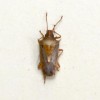 The bagrada bug is a pest of concern to Florida agriculture, and there are several similar species with which it may be confused. Bagrada bugs have been detected on plant material in trucks traveling across state borders. Twelve interceptions have been made from 2011-2013 at the FDACS agricultural inspection stations along the interstate at the Florida border. Due to the number of recent interceptions, and the ability of this pest to feed on many plants, the bagrada bug has potential to establish in Florida. Therefore, monitoring, surveillance, and educational efforts have begun in Florida to facilitate early detection and rapid response as the spread of the bagrada bug continues to other areas. This 7-page fact sheet was written by Eric LeVeen and Amanda C. Hodges, and published by the UF Department of Entomology and Nematology, July 2014.
The bagrada bug is a pest of concern to Florida agriculture, and there are several similar species with which it may be confused. Bagrada bugs have been detected on plant material in trucks traveling across state borders. Twelve interceptions have been made from 2011-2013 at the FDACS agricultural inspection stations along the interstate at the Florida border. Due to the number of recent interceptions, and the ability of this pest to feed on many plants, the bagrada bug has potential to establish in Florida. Therefore, monitoring, surveillance, and educational efforts have begun in Florida to facilitate early detection and rapid response as the spread of the bagrada bug continues to other areas. This 7-page fact sheet was written by Eric LeVeen and Amanda C. Hodges, and published by the UF Department of Entomology and Nematology, July 2014.
http://edis.ifas.ufl.edu/in1041
Tag: Stink Bugs
Stink Bugs in Florida Rice
 Although many different insects can be found in rice fields in Florida, stink bugs are currently considered the most important pest. Jones and Cherry reported that the rice stink bug was the dominant species, comprising more than 95% of the total stink bug population. Cherry et al. (1998) reported that the stink bug Oebalus ypsilongriseus was widespread in Florida rice fields. This was the first report of this species being found in commercial rice fields in the United States. Cherry and Nuessly (2010) reported that the stink bug Oebalus insularis is now widespread in Florida rice fields. This was the first report of this species being found in commercial rice fields in the United States. The stink bug complex attacking Florida rice is the most diversified and unique stink bug complex in US rice production. This 4-page fact sheet was written by Ron Cherry, and published by the UF Department of Entomology and Nematology, October 2013.
Although many different insects can be found in rice fields in Florida, stink bugs are currently considered the most important pest. Jones and Cherry reported that the rice stink bug was the dominant species, comprising more than 95% of the total stink bug population. Cherry et al. (1998) reported that the stink bug Oebalus ypsilongriseus was widespread in Florida rice fields. This was the first report of this species being found in commercial rice fields in the United States. Cherry and Nuessly (2010) reported that the stink bug Oebalus insularis is now widespread in Florida rice fields. This was the first report of this species being found in commercial rice fields in the United States. The stink bug complex attacking Florida rice is the most diversified and unique stink bug complex in US rice production. This 4-page fact sheet was written by Ron Cherry, and published by the UF Department of Entomology and Nematology, October 2013.
http://edis.ifas.ufl.edu/in1009
A Stink Bug Euschistus quadrator Rolston (Insecta: Hemiptera: Pentatomidae) (EENY523/IN937)
 Euschistus quadrator, like other stink bugs, is highly polyphagous. It is found on weeds such as clover, vetch and other legumes. It feeds on many different crops, though it is primarily found on cotton, soybeans and corn. Stink bugs cause injury to various fruits and vegetables by feeding, resulting in significant quality and yield loss. They have piercing-sucking mouthparts and most feed primarily on fruits and seeds. This 5-page fact sheet was written by Sara A. Brennan, Joseph Eger, and Oscar E. Liburd, and published by the UF Department of Entomology and Nematology, June 2012.
Euschistus quadrator, like other stink bugs, is highly polyphagous. It is found on weeds such as clover, vetch and other legumes. It feeds on many different crops, though it is primarily found on cotton, soybeans and corn. Stink bugs cause injury to various fruits and vegetables by feeding, resulting in significant quality and yield loss. They have piercing-sucking mouthparts and most feed primarily on fruits and seeds. This 5-page fact sheet was written by Sara A. Brennan, Joseph Eger, and Oscar E. Liburd, and published by the UF Department of Entomology and Nematology, June 2012.
http://edis.ifas.ufl.edu/in937
EENY433/IN796 Brown Stink Bug Euschistus servus (Say) (Insecta: Hemiptera: Pentatomidae)
EENY-433, 5-page illustrated fact sheet by Celina Gomez and Russell F. Mizell III, is part of the Featured Creatures collection. It describes this serious stink bug pest in most seed, grain, nut, and fruit crops in the southern U.S. — its distribution, description, life cycle and biology, hosts, plant damage, and management. Includes selected references. Published by the UF Department of Entomology and Nematology, February 2009.
http://edis.ifas.ufl.edu/IN796